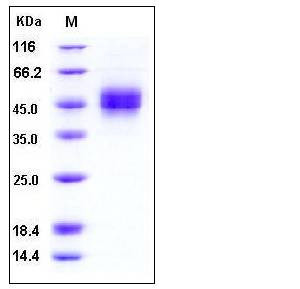Human MICB Protein (His Tag)
PERB11.2
- 100ug (NPP2343) Please inquiry
| Catalog Number | P10759-H08H |
|---|---|
| Organism Species | Human |
| Host | Human Cells |
| Synonyms | PERB11.2 |
| Molecular Weight | The recombinant human MICB consists of 287 amino acids and has a predicted molecular mass of 33 kDa. In SDS-PAGE under reducing conditions, the apparent molecular mass of rh MICB is approximately 45-50 kDa due to glycosylation. |
| predicted N | Ala 23 |
| SDS-PAGE |  |
| Purity | > 98 % as determined by SDS-PAGE |
| Protein Construction | A DNA sequence encoding the extracellular domain of human MICB (NP_005922.2) (Met 1-Gly 298) was expressed with a C-terminal polyhistidine tag. |
| Bio-activity | Immobilized human MICB-His (P10759-H08H) at 10 μg/ml (100 μl/well) can bind S4-Fc3L3-NKG2D (P10575-H01S), The EC50 of S4-Fc3L3-NKG2D (P10575-H01S) is 0.52-1.2 μg/ml. |
| Research Area | |
| Formulation | Lyophilized from sterile PBS, pH 7.4 1. Normally 5 % - 8 % trehalose, mannitol and 0.01% Tween80 are added as protectants before lyophilization. Specific concentrations are included in the hardcopy of COA. |
| Background | MHC class I polypeptide-related sequence B, also known as MICB, is a heavily glycosylated protein serving as a ligand for the type I I receptor NKG2D. MICB shares 85% amino acid identity with MICA, a closely related protein, both of which contain three extracellular immunoglobulin-like domains, but without capacity to bind peptide or interact with beta-2-microglobulin. acting as a stress-induced self-antigen, binding of MICB to the NKG2D receptor activates the cytolytic response of natural killer (NK) cells, CD8+αβ T cells, and γδ T cells on which the receptor is expressed. MICA/B are minimally expressed on normal cells, but are frequently expressed on epithelial tumors and can be induced by bacterial and viral infections. MICA/B recognition thus is involved in tumor surveillance, viral infections, and autoimmune diseases. |
| Reference |
